Can you guys recommend anyone to charcoal blue a Fowler barrel? I feel comfortable fire bluing small parts but don’t want to risk ruining a barrel. I still might finish the Kibler Fowler white if it’s not cost effective or less pc. My idea was to charcoal blue the barrel, leave the lock a semi-polished white with fire blued screws. What do yall think? Seem pretty pc 1760-1770’s?
You are using an out of date browser. It may not display this or other websites correctly.
You should upgrade or use an alternative browser.
You should upgrade or use an alternative browser.
Who charcoal blues Fowler barrels
- Thread starter Texcl2
- Start date

Help Support Muzzleloading Forum:
This site may earn a commission from merchant affiliate
links, including eBay, Amazon, and others.
You could do slow rust blue. Pretty simple, swab on, let oxidize a bit, then I use a stove pipe set in a pot of boiling water to steam, rather than boil. Never let true rust appear, always steam when you have just a light coat of oxidation.
- Joined
- Nov 26, 2005
- Messages
- 5,269
- Reaction score
- 11,151
Hi,
If you want to be historically correct, Kibler's fowler is a modest quality trade gun or export fowler. It would probably not have a blued barrel of any sort. For this style gun, I apply instant blue to the barrel and then rub it back with a maroon Scotch Bright pad. The idea is to create a darkened tarnish.
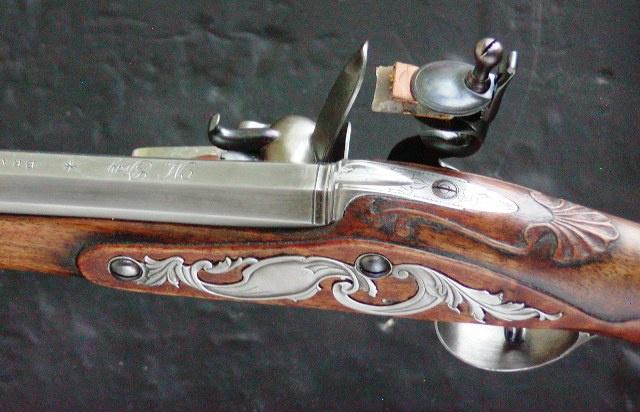
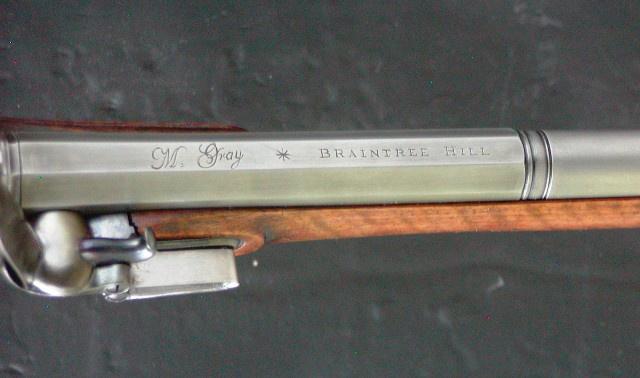
dave
If you want to be historically correct, Kibler's fowler is a modest quality trade gun or export fowler. It would probably not have a blued barrel of any sort. For this style gun, I apply instant blue to the barrel and then rub it back with a maroon Scotch Bright pad. The idea is to create a darkened tarnish.


dave
Ok, well that simplifies things lol. I was wondering how grades and quality factored in. Thanks for the advice.
- Joined
- Nov 26, 2005
- Messages
- 5,269
- Reaction score
- 11,151
Hi Texcl2,
A high quality British gun during the late 1760s-1770s might have a barrel that was rust browned but it would also have a standing breech, flat barrel keys, better carving, and would not have a round-faced lock. A high quality gun from that time could have a Spanish barrel that was temper blued or a few might be charcoal blued. However, that was for best quality guns. Kibler's fowler is a fine gun but it does not represent a best quality gun from the time period. Guns of that class would not likely have been blued or browned, and barrels simply finished in the white.
dave
A high quality British gun during the late 1760s-1770s might have a barrel that was rust browned but it would also have a standing breech, flat barrel keys, better carving, and would not have a round-faced lock. A high quality gun from that time could have a Spanish barrel that was temper blued or a few might be charcoal blued. However, that was for best quality guns. Kibler's fowler is a fine gun but it does not represent a best quality gun from the time period. Guns of that class would not likely have been blued or browned, and barrels simply finished in the white.
dave
Yes, I understand it was a working man’s or a hardware store quality gun. Which is appealing as they were very common. I thought browning was much more common closer to the 1800’s and beyond, and was not really used before that time? I will stick to the bright finish but will most likely fire blue the screws for contrast. I’m going to add some character to the side plate as well as I’ve never seen a plain one, nothing major but at least some lines. I need to look at more originals and get some ideas within my wheelhouse ( which isn’t much lol). Thanks for all the great help and for sharing your experience with us! Great Fowler by the way! Is that English walnut? I love the color.
- Joined
- Nov 26, 2005
- Messages
- 5,269
- Reaction score
- 11,151
Hi Texcl2,
You are most welcome and thanks for complimenting the fowler. It is my apprentice Maria's first gun. It is English walnut and the rough blank was purchased from Jim Kibler. Jim just about gave it to us as a gift given what he charged.
Tex, I believe rust browning started to take off on high quality English guns in the 1770s because they introduced stub and stub twist barrels at that time. No doubt they appreciated the rust resistance of browning and the reduction of glare on the barrel when shooting. But they knew about it decades previously yet no mid century guns show evidence of rust browning. I think it became a popular fashion when the twist barrels arrived and browning created a dramatic marbled appearance.

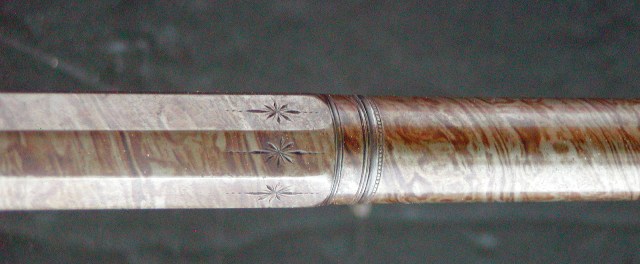
Let me be clear, this is NOT Damascus. It contains very little steel. The colors are mostly created by iron of different density.
So by the 1780s, rust browning was popular on good quality English guns. In America you just don't see evidence of that until the 19th century.
dave
You are most welcome and thanks for complimenting the fowler. It is my apprentice Maria's first gun. It is English walnut and the rough blank was purchased from Jim Kibler. Jim just about gave it to us as a gift given what he charged.
Tex, I believe rust browning started to take off on high quality English guns in the 1770s because they introduced stub and stub twist barrels at that time. No doubt they appreciated the rust resistance of browning and the reduction of glare on the barrel when shooting. But they knew about it decades previously yet no mid century guns show evidence of rust browning. I think it became a popular fashion when the twist barrels arrived and browning created a dramatic marbled appearance.


Let me be clear, this is NOT Damascus. It contains very little steel. The colors are mostly created by iron of different density.
So by the 1780s, rust browning was popular on good quality English guns. In America you just don't see evidence of that until the 19th century.
dave
Capt. Jas.
58 Cal.
- Joined
- Aug 19, 2005
- Messages
- 3,062
- Reaction score
- 1,378
Temper or plate blue was also an option if you are wanting a blue on that level of trading gun. It was even done on some trade guns to the Indians.
I’ve never heard of temper or plate blue, is that heat bluing where they put the hot mandrel in the barrel till it turned the color they wanted?
Dave, I’ve owned a couple European percussion shotguns and a percussion combination gun with that brown twist finish, I have always loved that finish. They were all percussion guns so definitely 1800’s. I’m hoping the black walnut stock I get won’t be too dark or have that purple color to it. I’d like to make it look as close to English as I can.
Dave, I’ve owned a couple European percussion shotguns and a percussion combination gun with that brown twist finish, I have always loved that finish. They were all percussion guns so definitely 1800’s. I’m hoping the black walnut stock I get won’t be too dark or have that purple color to it. I’d like to make it look as close to English as I can.
Last edited:
- Joined
- Nov 26, 2005
- Messages
- 5,269
- Reaction score
- 11,151
Hi Tex,Dave, I’ve owned a couple European percussion shotguns and a percussion combination gun with that brown twist finish, I have always loved that finish. They were all percussion guns so definitely 1800’s. I’m hoping the black walnut stock I get won’t be too dark or have that purple color to it. I’d like to make it look as close to English as I can.
This will help. You have to scroll down a bit to get to the part about staining black walnut.
https://www.muzzleloadingforum.com/...dublin-castle-short-land-musket.138872/page-7
dave
Capt. Jas.
58 Cal.
- Joined
- Aug 19, 2005
- Messages
- 3,062
- Reaction score
- 1,378
I’ve never heard of temper or plate blue, is that heat bluing where they put the hot mandrel in the barrel till it turned the color they wanted?
They used a brazier or heated plate to pass the barrel over it with a mandrel thru it as I understand it. Many of the original barrels i have seen were lightly dovetailed to hold the lugs for brazing.
I used multiple mapp gas torches to make a rather poor amateur attempt on this barrel. Consistency was extremely difficult.
Needless to say, bright or using some cold blue backed off is a safer and easier option but I had to give it a go and will probably try again with a heated plate.
Attachments
smoothshooter
50 Cal.
Hi,
If you want to be historically correct, Kibler's fowler is a modest quality trade gun or export fowler. It would probably not have a blued barrel of any sort. For this style gun, I apply instant blue to the barrel and then rub it back with a maroon Scotch Bright pad. The idea is to create a darkened tarnish.


What is your favorite brand of instant blue?
dave
I like the way that turned out, the blue color is very noticeable. I’ve been trying to look up pictures of original flint Fowlers online but have been having a hard time finding lower to mid quality guns in reasonable shape. I wonder if the Tower of London has an online photo library one can access.
Dave, thanks for the link. That was just the info I’m looking for. I was planning on using the same type of dye and was glad to read about its actual application. I was thinking of using the black first on my scrap pieces to see how it looked, that was the first I’ve read of anyone doing that with black walnut. I also bought bone black to try in conjunction with the finish. This will also be my first project using a scraper so expect some questions about that, lol. Thanks again guys!
Dave, thanks for the link. That was just the info I’m looking for. I was planning on using the same type of dye and was glad to read about its actual application. I was thinking of using the black first on my scrap pieces to see how it looked, that was the first I’ve read of anyone doing that with black walnut. I also bought bone black to try in conjunction with the finish. This will also be my first project using a scraper so expect some questions about that, lol. Thanks again guys!
Last edited:
To answer the initial question: nobody does charcoal heat bluing for hire. A few people have done it on barrels for their guns or guns they have made for clients. It’s suggested that the barrel be completely covered with charcoal coals in a trough, pulled out and wire brushed, and returned to eventually cool.
Be careful using significant heat on our barrels. The sights and lugs are soft soldered on so they will fall off if you exceed the solder melting point. This is significantly below the temperature associated with "temper blue"
Good point in the white it is lol.
For sure!Be careful using significant heat on our barrels. The sights and lugs are soft soldered on so they will fall off if you exceed the solder melting point. This is significantly below the temperature associated with "temper blue"
- Joined
- Nov 26, 2005
- Messages
- 5,269
- Reaction score
- 11,151
Hi,
Often Spanish gun barrels were tempered blued but they were usually held to the stock by barrel bands rather than lugs. Even English makers often used inlet barrel bands when stocking up Spanish barrels.
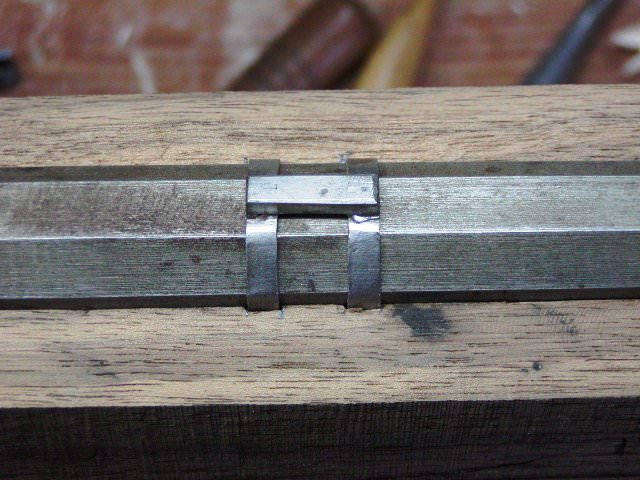

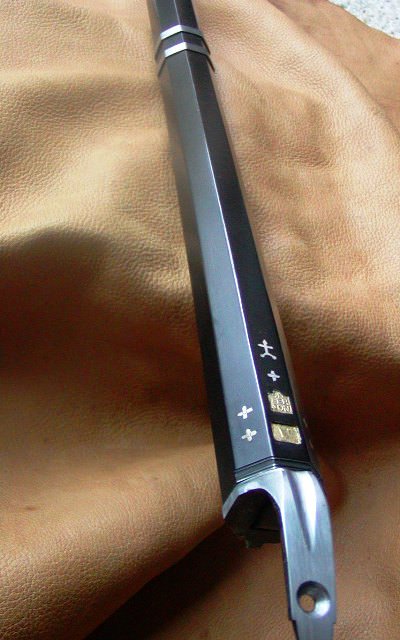
dave
Often Spanish gun barrels were tempered blued but they were usually held to the stock by barrel bands rather than lugs. Even English makers often used inlet barrel bands when stocking up Spanish barrels.



dave
Similar threads
- Replies
- 46
- Views
- 5K
- Replies
- 32
- Views
- 7K
- Replies
- 12
- Views
- 2K






